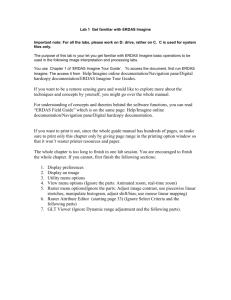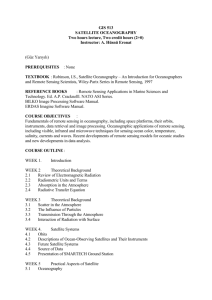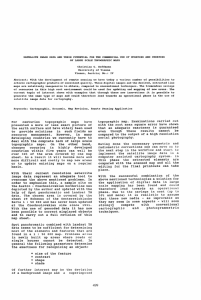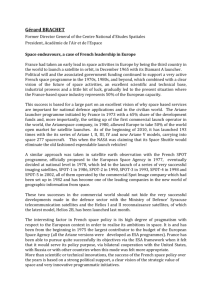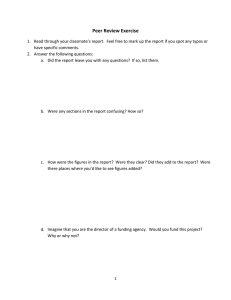USE OF PC .. ERDAS IN SATELLITE· MAPPING/GIS EDUCATION 1
advertisement
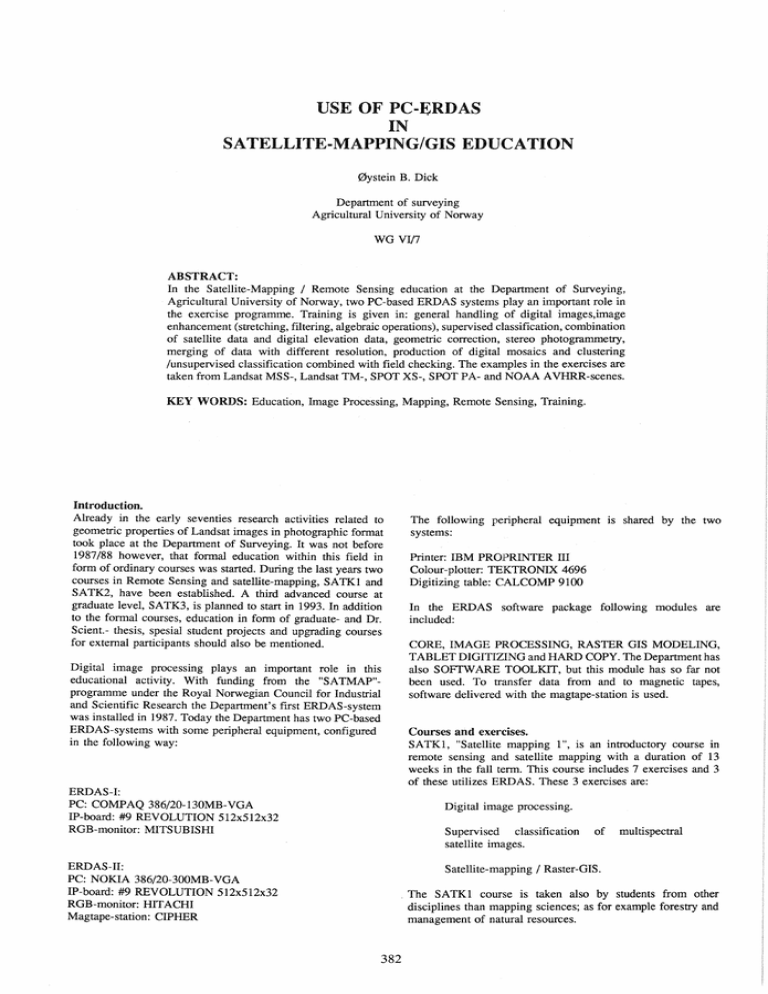
USE OF PC .. ERDAS IN SATELLITE· MAPPING/GIS EDUCATION 0ystein B. Dick Department of surveying Agricultural University of Norway WG VII7 ABSTRACT: In the Satellite-Mapping 1 Remote Sensing education at the Department of Surveying, Agricultural University of Norway, two PC-based ERDAS systems play an important role in the exercise programme. Training is given in: general handling of digital images,image enhancement (stretching, filtering, algebraic operations), supervised classification, combination of satellite data and digital elevation data, geometric correction, stereo photogrammetry, merging of data with different resolution, production of digital mosaics and clustering lunsupervised classification combined with field checking. The examples in the exercises are taken from Landsat MSS-, Landsat TM-, SPOT XS-, SPOT PA- and NOAA AVHRR-scenes. KEY WORDS: Education, Image Processing, Mapping, Remote Sensing, Training. Introd.uction. Already in the early seventies research activities related to geometric properties of Landsat images in photographic format took place at the Department of Surveying. It was not before 1987/88 however, that formal education within this field in form of ordinary courses was started. During the last years two courses in Remote Sensing and satellite-mapping, SATKI and SATK2, have been established. A third advanced course at graduate level, SATK3, is planned to start in 1993. In addition to the formal courses, education in form of graduate- and Dr. Scient.- thesis, spesial student projects and upgrading courses for external participants should also be mentioned. The following peripheral equipment is shared by the two systems: Printer: IBM PROPRINTER III Colour-plotter: TEKTRONIX 4696 Digitizing table: CALCOMP 9100 In the ERDAS software package following modules are included: CORE, IMAGE PROCESSING, RASTER GIS MODELING, TABLET DIGITIZING and HARD COPY. The Department has also SOFfWARE TOOLKIT, but this module has so far not been used. To transfer data from and to magnetic tapes, software delivered with the magtape-station is used. Digital image processing plays an important role in this educational activity. With funding from the "SATMAP"programme under the Royal Norwegian Council for Industrial and Scientific Research the Department's first ERDAS-system was installed in 1987. Today the Department has two PC-based ERDAS-systems with some peripheral equipment, configured in the following way: Courses and exercises. SATKl, "Satellite mapping I", is an introductory course in remote sensing and satellite mapping with a duration of 13 weeks in the fall term. This course includes 7 exercises and 3 of these utilizes ERDAS. These 3 exercises are: ERDAS-I: PC: COMPAQ 386/20-130MB- VGA IP-board: #9 REVOLUTION 512x512x32 RGB-monitor: MITSUBISHI ERDAS-II: PC: NOKIA 386/20-300MB- VGA IP-board: #9 REVOLUTION 512x512x32 RGB-monitor: HITACHI Magtape-station: CIPHER Digital image processing. Supervised classification satellite images. of multispectral Satellite-mapping 1 Raster-GIS. . The SATK I course is taken also by students from other disciplines than mapping sciences; as for example forestry and management of natural resources. 382 In the spring term (duration 13 weeks) the course SATK2 is offered. This is more specialized, and is aimed primarily at students of mapping sciences. In this course ERDAS is used in all the four following exercises: Satellite image geometry. Determination of terrain elevation from a single oblique SPOT scene. Special image-processing procedures. Colour-hardcopy production, Unsupervised classification (clustering) and Field-control (collection of ground-truth). All the exercises have in common that they are based on subsets taken from different types of satellite-scenes in digital format. After processing of the initial data-sets by the various ERDAS-functions according to the guidelines given in the exercise text, the result will be one or more new image files. It will often be important to compare two or more images. This is obtained by displaying the images on the RGB-screen simultanously. In addition to a written description of the work carried out during the exercise, the students also deliver a copy of the "Result Screen-Images" on a diskette. PIC is useful for saving the "Result Screen-Image" as an image file. Figure la. Various types of contrast stretch enhancement of a panchromatic SPOT subscene. The descriptions of the exercises given below are accompanied by illustrations of such "Result Screen-Images". The illustrations in this paper are produced as B/W hard-copies on the Tektronix plotter at reduced scale. The quality of these illustrations is of course much lower here than on the screen, but it is hoped that they will contribute to a better understanding of the use of ERDAS in the exercises. In the second part of this exercise, the initial image is a subset of a Landsat TM scene. The data-set contains 6 bands, as the thermal band with the coarser resolution is removed. For further processing, as in the first part, a secondary subset is generated. In addition to apply the skill obtained during the first part of the exercise, the principal components transform PRINCE is used. The "Result Screen-Image" is shown in Figure lb. Text is written by ANNOTAT. SATKI. Exercise 1. Digital image processing. In this exercise the students get in touch with ERDAS for the first time. The aim of the exercise is to familiarize the students with ERDAS and with basic concepts and procedures within the field of digital image processing. The main emphasis in this exercise is on image enhancement methods. The initial satellite image is a subset of a panchromatic SPOT scene covering the area where the University is located. The subset measures 768 lines by 768 pixels. The first step is to show the image on the screen using READ. (The file containing the statistics for this initial image has already been generated). Using CURB OX and SUBSET, a secondary subset of 200 x 200 pixels is produced. A -.STA-file is generated by BSTATS, and the functions DHISTOEQ, STRETCH and DCONVLV are then used to produce enhanced derivatives of the original. These images are then compared in the "Result Screen-Image" as shown in Figure lao CURSES is used for the comparison of corresponding pixel-values in the differently stretched images. Figure 1b. False Colour Composite and single band display of selected original and principal components Landsat TM data. 383 SA TKI. Exercise 2. Supervised classification of multispectral satellite images. This exercise deals mainly with supervised classification. Two data-sets, a 4-band Landsat MSS image and a 3-band SPOT XS image are used. Again CURBOX and SUBSET are used to generate secondary subsets. Training areas are picked by DIGSCRN. As in the previous exercise, also these images cover the area where the University is located, so the students have a fairly good idea of what is present on the ground. Signatures are generated with SIGEXT and SIGMAN, and ELLIPSE is used for an evaluation of the signatures. In MAXCLAS, the students themselves decide which classification algorithm to use. Supplementary texts are written by ANNOTAT as shown in Figure 2. This "Result Screen-Image" contains the original MSS subset as a False Colour Composite (FCC), the result of the MSS classification and also the result of the classification based on the SPOT XS data. The image in the lower right hand corner of Figure 2 is a small portion of the classified MSS image, enlarged to the same scale as the XS classification result. Since the MSS image is geocoded and the XS image has only been through a system-correction (level IB), the two images are slightly differently orientated. It should also be mentioned that the functions COLORMOD and RECODE are introduced in this exercise. DTM is a -.LAN-file. By the aid of CURSES, the studens pick X, Y and Z coordinates and compare the results with a topographic map. The terrain-elevation file is also used to demonstrate various possibilities in the COLORMOD function. The terrain-elevation file exists also as a -.GIS file with 6 classes. In the last part of the exercise, MATRIX is used to find those areas which fulfil certain snowcover- as well as terrain elevation requirements. A third -.GIS-file which defines the "Nore" catchment area, makes it possible to show only the part of the actual area which is inside the catchment. Figure 3 shows the "Result Screen-Image". Figure 3. Digital terrain elevation data and raster representation of "Nore" catchment area in combination with NOAA A VHRR data. SATK2. Exercise 1. Satellite image geometry. In the first part of the exercise, CURSES in combination with a small scale atlas-map, is used to compare the scale in the central and in the marginal part of a NOAA AVHRR image which has not been geometrically corrected. In this way the effects of a large viewing angle and the curved earth surface are illustrated. Figure 4a shows the "Result Screen-Image" from this part of the exercise. Figure 2. Supervised classification of Landsat MSS and SPOT XS subscenes. SATKI. Exercise 3. Satellite mapping / Raster-GIS. The purpose of this exercise is to demonstrate the close connection which exists between satellite images in digital format and other types og geo-data in raster format. The example in this exercise is taken from a snow mapping project carried out in collaboration between Fjellanger Wider0e A.S. (a privately owned surveying and mapping company), Norwegian State Power Board, Norwegian Computing Centre and Norwegian Hydrotechnical Laboratory. A -.GIS-file showing 6 classes of snowcover is derived from the NIR band in a NOAA A VHRR image. The image, as well as the -.GIS-file, are referenced to the UTM coordinate system. The resolution in terms of pixel size is 1 x 1 km. The State Mapping Authority has provided a digital terrain model in raster format with corresponding resolution covering the same area. Originally this Figure 4a. Geometric properties of satellite imagery illustrated with subsets of a NOAA AVHRR scene. 384 The rest of the exercise is devoted to geometric correction and re-sampling. In order to illustrate the main principles, an artificial image with 10 lines by 10 pixels is used initially. A ground control point file is established from given pairs of control points by GCP. (Keyboard mode is used for file- as well as map-coordinates). The transformation equation is determined by COORDN. LRECTIFY is used to produce one image-file for each of the three resampling methods Nearest Neighbour (N), Bilinear Interpolation (B) and Cubic Convolution (C) as shown in Figure 4b. The students also perform, based on the transformation equation, a "manual resampling-calculation" for some selected pixels. In this connection it can be mentioned that the way COORDN shows the coeffisients of the transformation equation is somewhat confusing. Figure 4c. Image rectification with various methods. SATK2. Exercise 2. Determination of terrain elevation from a single oblique SPOT scene. The main emphasis in this exercise is rather on the understanding of the satellite image geometry than on the use of the ERDAS system. By measuring distances (expressed in pixels) by CURSES in a level lA (not geometrically corrected) panchromatic SPOT subscene, the students shall calculate the terrain elevation for selected pixels in the image from known true horisontal distances. In addition to the subscene in which the measurements are carried out, another obliqe SPOT subcene with a different view angle covering the same area is also available. Together these two subscenes form a stereo model. By intelligent use of READ, an image which can be stereoscopically viewed through red/green glasses (the anaglyph method) is produced on the screen. As this paper is in B/W, the effect cannot be demonstrated here, but on the display screen of the ERDASsystem, the effect is striking. Since the two images in the stereo-model are taken from different orbits, the orientations of the two images are slightly different when they are registered to a common reference system, as shown in Figure 5. Figure 4b. Transformation of a synthetic image with different resampling algorithms. An artificially distorted version of an uncorrected Landsat MSS image (denoted "AR=6: I" in Figure 4c) is the basis for the part of the exercise which deals with capture of ground control points using the digitizing tablet. The result of this rectification is denoted "GCP" in Figure 4c. In the next part of the exercise, GCPs are measured on a map and entered into ERDAS with the keyboard. The map is a large scale topographic map (scale 1:5000) and the image is a SPOT level IB panchromatic subscene. The result of this rectification process is denotetd "SPOT-MAP" in Figure 4c. When rectifying the image, the students are asked to define comers corresponding' to one of the 1:5000 map sheets covering the actual area. In the last part of the exercise the goal is to perform a "system correction" of the same distorted Landsat MSS image as is mentioned above. Based on the "aspect ratio", the earth rotation and the angle between the orbital- and the equatorial plane, the transformation equation is calculated. The result of the subsequent resampling is denoted "MOD" in Figure 4c. Figure 5. Stereo model from two oblique panchromatic SPOT subscenes. 385 SA TK2. Exercise 3. Special image-processing procedures. The introductory topic in this exercise is the transformation from RGB colour-space to IHS colour-space. ALGEBRA is the ERDAS function which is used to demonstrate this. The "Result Screen-Image" in Figure 6a shows an original SPOT XS subscene, the components I, Hand S after the transformation and also the result of an IHS2RGB transformation when the original image is used as input. The sixth image in Figure 6a is the result of an IHS2RGB transformation of the IHS image. This result is thus the same as the original RGB-image. In the second part of the exercise the knowledge about the IHS transformation obtained in the first part, is applied to the generation of a combined SPOT XS/P A image. In this process image to image rectification is included. It is in this connection necessary to determine both sets of GCP coordinates directly in the images. Figure 6b shows the "Result Screen-Image" from this part of the exercise. It is realized that PC-ERDAS (not even Version 7.5) is ideal for a task like this. In the last part a digital mosaic shall be made from two slightly overlapping Landsat MSS subscenes. Important functions used in this procedure are DIGSCRN, CUTTER and STITCH. Due to different dates of acquisition, the radiometric properties of the two subscenes are different. HSTMATCH is therefore used to complete the production of the mosaic. Figure 6c shows the result. Figure 6a. Display of original and IHS-transformed SPOT XS data. Figure 6c. Mosaicing of Landsat MSS subscenes. SATK2. Exercise 4. Colour-hardcopy production, Unsupervised classification (Clustering) and Field-control (Collection of ground-truth). The digital image used in this exercise is a subset of a level 2B (precision-corrected) multispectral SPOT-scene which covers an area in Valle in Setesdal in south Norway. This area has been chosen for the exercise because a privately owned consulting company (VIAK) in collaboration with a research foundation (Telemarksforskning) has produced a vegetation-map of the area based on the same set of data. Figure 6b. Merging of SPOT XS with SPOT PA data. 386 Based on the knowledge obtained during the previous exercises in the courses SATKI and SATK2, the studens produce an enhanced False Colour Composite suitable for general visual interpretation. A colour-hardcopy, which is later used during the field check, is made by the Tektronix ink-jet plotter. The main contents of this exercise is unsupervised classification or "clustering". As for the other exercises in the SA TKcourses, this one is also carried out in groups of two and two students. Each group shall carry out two unsupervised classifications. The algorithms ISODATA and CLUSTR are used.The number of classes is however not the same for the different groups. By comparing the results, it is then possible to get an impression of how the choice of algorithm and number of classes inf1uences the result. An example is shown in Figure 7. The result of the unsupervised classification is also produced as a colour hardcopy, which is used during the field-work. With support from the already existing vegetation map and observations in the field, the aim is to combine the "spectralclasses" from the unsupervised classification into so-called "information classes". Eventually the final result is also produced as a hardcopy on the Tektronix colour ink-jet plotter. ERDAS -.LAN and -.GCP files as input. The result is written to a -.GCP file. It is then possible to use the GCPERR program for further analysis of the results. (For some reason GCPERR is not included in ERDAS versions later than 7.3. This is considered as unfortunate, as the lack of this program reduces the total functionality of the system). In connection with teaching and training given outside the university, often only standard VGA graphic capability is available for presentation of satellite images and thematic maps in raster format. Therefore software which makes it possible to use standard VGA graphics for the presentation of -.GIS/-.TRL files has been developed. VGA presentation of -.LAN files can be obtained by conversion via -.GIS/-.TRL files using RGBCLUS and similar methods. In order to utilize equipment for slide production in the "DTP-world" outside the university, software for conversion of -.LAN files to 24 bit TARGA format has also be~n developed. Concluding remarks. In general we consider PC-ERDAS as a well developed and "mature" system. The way of thinking which has been the basis for the design of the system's functionality, has evidently been strongly influenced by wide experience within the field of mapand satellite-image application. PC-ERDAS, even without LAPLINK, offers good possibilities for integration of image data and GIS. Since geodesy and photogrammetry are central diciplines at the Department of Surveying, problems related to geometry play an important role also in the teaching of satellite mapping. As described above, ERDAS is a useful tool in this connection. There seems however to be some inconsistency between the different ERDAS programs related to geometric rectification. The constants in transformation equations are for example denoted differently in the various programs and supplementary documentation. This leads to some confusion for the students, and should be improved in future revisions. Dealing with geometric rectification, we would also like to point out that what we miss in PC-ERDAS, is a real "split screen" functionality, which can be useful, particularly in connection with image to image registration. Figure 7. Unsupervised classification based on different clustering algorithms. We have got the understanding that version 7.5 is the last stage in the development of the ERDAS software under MS-DOS. Transition to "Imagine" under UNIX for PC users implies considerble investments. For many university institutions like ours, funding is mostly rather limited. In an educational environment, continued use of PC-ERDAS may in addition to the economical also have some other advantages. The studens are familiar with MS-DOS and the menu-driven user interface is well suited for teaching. From this point of view it should be possible to teach digital satellite image processing in a meaningful way with PC-ERDAS well into the next century. On the other hand, the lack of a graphic user interface, as for example the one in "Imagine", will give the students the impression that they are working with obsolete equipment, which may have a bad inf1uence on their motivation and their interest in the subject. It is therefore hoped that ERDAS will reconsider to develop new versions running under MS-DOS, tentatively with a graphic user interface. Research and development activities related to ERDAS. ERDAS is also considered as a useful tool in connection with the research and development activities related to satellitemapping which are carried out at the Department of Surveying. A comparative study of the effect of different rectification procedures applied to SPOT data is now carried out utilizing ERDAS to a large extent. In connection with the evaluation of the geometric quality in this project, the "chip extraction" capability in GCP (new in version 7.4) has shown most useful. As part of the same study, a computer program for automatic measurement of geometric deviations between images rectified with different procedures, based on image correlation, has been developed. The program itself runs outside ERDAS, but it uses 387
